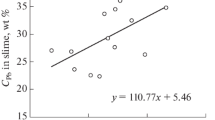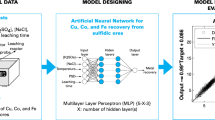Abstract—
Assurance of reliable and failure-free operation of power-generating equipment at thermal power plants is closely linked with improvement of methods for diagnosing and predicting the behavior of impurities over the process path of power units. The article discusses the current state and development prospects of techniques for diagnosing and predicting the behavior of impurities using cycle chemistry-monitoring systems. The application of mathematical models in such systems is studied, on the one hand, as a method for displaying the current information on the behavior of impurities over the power unit process path and, on the other hand, as a method for predicting their behavior. The possibility to use mathematical models when the water quality degrades, when the concentration of hydrocarbonates in the path increases, and also in analyzing the quality of ultrapure waters is examined. The article presents models based on the measurements of water sample conductivity upstream and downstream of the H-cation exchange filter, and pH values. The possibility to determine, by calculation, the rate of corrosion processes over the process path of a nuclear power plant unit using the hydrogen number, mass action law equations, material balance equations, and normalization conditions is analyzed. Impurity behavior prediction models based on neural networks are analyzed. The main types of mathematical models based on the water ionic composition, material balance, and neural networks that are used in cycle chemistry-monitoring systems are given; their advantages and drawbacks are pointed out, and current trends in the development of these models are formulated.

Similar content being viewed by others
REFERENCES
L. M. Zhivilova and V. V. Tarkovskii, “The system and facilities for automatic monitoring of the water chemistry at thermal power stations,” Therm. Eng. 45, 544–550 (1998).
V. N. Voronov, O. V. Yegoshina, N. A. Bolshakova, and V. O. Yarovoy, “Cycle chemistry monitoring system as means of improving the reliability of the equipment at the power plants,” J. Phys.: Conf. Ser. 891, 012270 (2017). https://doi.org/10.1088/1742-6596/891/1/012270
V. N. Voronov, O. V. Egoshina, N. A. Bolshakova, V. O. Yarovoi, and Aie Min Latt, “Effect of water chemistry upsets on the dynamics of corrective reagent dosing systems at thermal power stations,” Therm. Eng. 63, 903–907 (2016). https://doi.org/10.1134/S0040601516120090
A. B. Larin, “Monitoring water chemistry of power units of combined heat and power plants with steam–gas turbines,” Vestn. IGEU, No. 3, 14–18 (2013).
N. A. Bol’shakova, Improving the System of Automatic Dosing of Corrective Reagents at Thermal Power Plants, Candidate’s Dissertation in Engineering (Moscow Power Engineering Inst., Moscow, 2021).
T. V. Lin, Development of Algorithms for the Diagnostics of Ionic Composition of the Coolant in Chemical-Technological Monitoring Systems at Thermal Power Plants, Candidate’s Dissertation in Engineering (Moscow Power Engineering Inst., Moscow, 2021).
Rules of Technical Operation of Power Plants and Grids of the Russian Federation (SPO ORGRES, Moscow, 2003) [in Russian].
V. K. Pauli, “An expert system for monitoring and appraising the operating conditions of boiler units at thermal power stations,” Therm. Eng. 44, 382–387 (1997).
A. B. Kolegov, B. M. Larin, A. B. Larin, and E. V. Kozyulina, “Introduction of the automatic chemical water chemistry control system for thermal power plants,” Vestn. IGEU, No. 4, 15–19 (2011).
RD 153-34.1-37.532.4-2001. General Technical Requirements for Chemical Process Water Chemistry Monitoring Systems for Thermal Power Stations (NPTs “Element”, Moscow, 2001).
A. A. Mostofin, “Calculation of pH values and electrical conductivity of aqueous solutions of NH3 and CO2,” Vodopodgot., Vodn. Rezhim Khimkontrol Parosilovykh Ustanovkakh, No. 2, 178–187 (1966).
H. Maurer, “On-line pH-measurement by differential cation and specific conductivity,” Presented at Int. Chemistry On-Line Process Instrumentation Seminar, Clearwater Beach, Fla., 1997.
VGB-R 450 L. Richtlinien für die Speisewasser, Kesselwasser und Dampfqualität für Kraftwerke / Industriekraftwerke (VGB PowerTech, Essen, Germany, 2006).
VGB-006-00-2012-09-EN. Sampling and Physic-Chemical Monitoring of Water and Steam Cycles (VGB PowerTech, Essen, Germany, 2012).
M. Lendi, H. Wagner, and P. Wuhrmann, “pH calculation by differential conductivity measurement in mixtures of alkalization agents,” PowerPlant Chem. 16, 1–8 (2014).
A. B. Larin and A. Ya. Sorokina (Ivanova), “Method for calculating the pH and concentrations of ionic impurities in feed water at thermal power plants by measuring the electrical conductivity,” Vestn. IGEU, No. 5, 10–15 (2016).
E. V. Kozyulina, B. M. Larin, and M. Yu. Oparin, “Industrial testing of the methodology for calculating the impurities of condensate and feed water of the supercritical pressure drum boiler,” Vestn. IGEU, No. 1, 47–51 (2002).
A. B. Larin and A. Ya. Sorokina (Ivanova), “Calculation of ionic impurities concentrations in extremely diluted aqueous solutions such as condensate and feed water in steam boilers (pb > 10 MPa),” Vestn. IGEU, No. 2, 13–17 (2017).
A. B. Larin, B. M. Larin, and M. P. Savinov, “Estimating the steam quality in power-generating boilers from electrical conductivity and pH measurements,” Therm. Eng. 68, 387–394 (2021). https://doi.org/10.1134/S0040601521040030
D. S. Smetanin, “Analysis of various algorithm types for searching for the causes of violations of the water chemistry of a thermal power plant,” Vodoochistka, Vodopodgot., Vodosnabzh., No. 1, 57–65 (2008).
V. N. Voronov and P. M. Gotovtsev, “Construction of a system for testing methods used to diagnose water chemistry on the basis of an experimental setup’s monitoring system,” Therm. Eng. 54, 511–514 (2007).
V. N. Voronov and I. M. Krasnoryadtsev, “Problems of mathematical modeling of thermal-hydraulic and water-chemical processes in steam generators of nuclear power plants with VVER,” Teploenergetika, No. 9, 78–80 (1991).
V. N. Voronov, P. N. Nazarenko, and A. G. Shmelev, “Modeling the dynamics of the development of violations of water chemistry by ionogenic impurities for PGV-1000 steam generators,” Teploenergetika, No. 11, 37–42 (1993).
V. N. Voronov, P. N. Nazarenko, and I. K. Chubukova, “Thermolysis and complex formation with hydrazine in steam-generating installations at power stations,” Therm. Eng. 43, 660–664 (1996).
V. N. Voronov, T. I. Petrova, and P. N. Nazarenko, “Mathematical models and their application in systems for the monitoring of chemical engineering at power plants,” Therm. Eng. 52, 317–320 (2005).
O. V. Endrukhina and V. N. Voronov, “Mathematical modeling of the water chemistry of a thermal power station under unsteady conditions,” Therm. Eng. 50, 590–593 (2003).
O. V. Endrukhina, V. N. Voronov, and P. N. Nazarenko, “Analyzing the efficiency of using a chemical-engineering monitoring system, taking the Cherepet district power station as an illustration,” Therm. Eng. 53, 600–604 (2006).
V. N. Voronov and O. V. Egoshina, “Mathematical model of the distribution of impurities along the power unit path for chemical-technological monitoring systems,” Nov. Ross. Elektroenerg., No. 10, 28–33 (2008).
M. Yu. Lukashov, “Electrolytic method for predicting the zone of deposition of coolant impurities in steam generators of thermal and nuclear power plants,” Bezop. Zhiznedeyat., Okhr. Okruzh. Sredy: Mezhvuz. Sb. Nauchn. Tr., No. 8, 82–83 (2004).
M. Yu. Lukashov, “Investigation of the relationship between solubility and electrical conductivity of coolant impurities at high temperatures and pressures at thermal power plants,” Izv. Vyssh. Uchebn. Zaved., Sev.-Kavk. Reg., Tekh. Nauki, No. 1, 41–44 (2005).
M. Yu. Lukashov, Improvement of Methods for Calculating Solubility and Predicting the Boundaries of Deposits of Coolant Impurities in the Water–Steam Duct of a Power Unit, Candidate’s Dissertation in Engineering (Novocherkassk, 2006).
Yu. V. Zenkevich and I. A. Kokoshkin, “Evaluation of the intensity of corrosion of boilers by the concentration of hydrogen in water and steam,” Vodopodgot., Vodn. Rezhim Khimkontrol Parosilovykh Ustanovkakh, No. 4, 163–168 (1972).
I. A. Kokoshkin, Determination of Hydrogen Dissolved in Water for Corrosion Control of Equipment of Thermal Energy Plants, Candidate’s Dissertation in Engineering (Leningrad, 1968).
V. N. Vinogradov and V. K. Avan, “Hydrogen gas analysis for diagnostics of water chemistries of thermal power plants’ boilers,” Vestn. IGEU, No. 2, 1–4 (2010).
M. H. Hassoun, Fundamentals of Artificial Neural Networks (MIT Press, Cambridge, Mass., 2005).
V. N. Kotenkov and V. F. Tyapkov, “The use of neural-networks simulation methods for permanently monitoring the high-temperature values of the hydrogen-ion indicator pHt of the coolant at nuclear power stations,” Therm. Eng. 51, 549–553 (2005).
P. M. Gotovtsev, V. N. Voronov, and D. S. Smetanin, “Analysis of the coolant condition with the help of artificial neural networks,” Therm. Eng. 55, 552–557 (2008).
V. G. Kritskii, I. G. Berezina, A. V. Gavrilov, E. A. Motkova, E. V. Zelenina, N. A. Prokhorov, S. P. Gorbatenko, and A. A. Tsitser, “Modeling of corrosion product migration in the secondary circuit of nuclear power plants with WWER-1200,” Therm. Eng. 63, 299–307 (2016). https://doi.org/10.1134/S0040601516040042
P. Gotovtsev and V. Voronov, “Cycle chemistry monitoring systems,” Power Plant Chem. 14, 158–162 (2012).
D. S. Smetanin, “Evaluation of water chemistry state of power plants with a water chemistry quality index,” Nov. Ross. Energ., No. 12, 3–5 (2004).
O. V. Egoshina and S. K. Zvonareva, “The program for calculating the universal indicator of water chemistry maintenance — Quality Index,” RF Software Registration Certificate No. 2022660393 (2022).
Funding
This study was financially supported by the Russian Science Foundation (grant no. 22-29-20314 “Development of a Simulation Model for Predicting the Behavior of Impurities over the Power Unit Path in the Cycle Chemistry-Monitoring Systems at Thermal Power Plants,” https://rscf.ru/project/22-29-20314/).
Author information
Authors and Affiliations
Corresponding author
Ethics declarations
The authors declare that they have no conflicts of interest.
Additional information
Translated by V. Filatov
Rights and permissions
About this article
Cite this article
Egoshina, O.V., Zvonareva, S.K. & Bol’shakova, N.A. Methods for Diagnosing and Predicting the Behavior of Impurities over the Power Unit Path in the Cycle Chemistry-Monitoring Systems at Thermal Power Plants (Review). Therm. Eng. 70, 362–369 (2023). https://doi.org/10.1134/S0040601523050014
Received:
Revised:
Accepted:
Published:
Issue Date:
DOI: https://doi.org/10.1134/S0040601523050014




